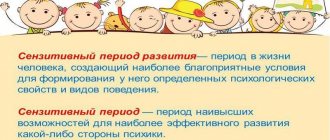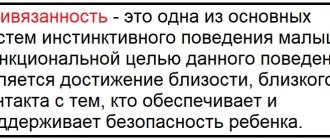G.M. Andreeva, E.E. Dmitrieva, Ya.L. Kolominsky in his works provides different interpretations of the term “communication”. Most often, scientists mean by this term the process by which information is transmitted.
From the point of view of S.L. According to Rubinstein, communication is the transmission of certain mental content using language.
From the point of view of I.A. Winter communication is a process during which both parties transmit information to each other and experience mutual understanding.
The concept of “communicative competence of preschool children”
Recently, the practice and theory of education has undergone major changes. A competent approach is introduced, which makes the problem of competence and its formation relevant. Researchers such as N.V. pay a lot of attention to this phenomenon in their works. Kuzmina, I.A. Zimnyaya, A.K. Markova and others.
The concept of “competence” has different meanings. Etymologically, this word is related to the term “competence”.
According to the explanatory dictionary of D.I. Ushakov’s competence and competency are two distinct terms. Competence is the authority of the source, its awareness.
And competence is a range of issues within which an individual has certain knowledge and experience, as well as authority.
Both Russian and foreign pedagogy perceive people’s relationships with other people as “communicative competence.”
This concept was first used in the direction of social psychology. Here it was viewed as the ability to create and maintain contacts with other people based on existing knowledge and skills.
Russian explanatory dictionaries perceive “competence” as a self-sufficient unit of language and define it as the level of mastery of a particular area of knowledge. The new encyclopedic dictionary represents this concept as the experience and knowledge a person has in a certain area. G.M. Bushueva views communicative competence from a slightly different angle. She uses this term to mean the totality of skills and abilities a person has that allow him to maintain effective communication with other people.
Let us also consider the interpretations of other scientists. O.V. Dzyuba writes that communicative competence is, first of all, a person’s situational adaptability, as well as his fluency in such tools of social interaction as nonverbal (non-speech) and verbal (speech) means.
The scientist also says that it is possible to distinguish a measure of competence in communications - this is how successful a person’s intended act of influence is and the means that he uses to impress others.
S.A. Ignatieva also gives her assessment of this concept. He writes that this is a system of internal resources available to a person, which he uses to establish communications with people participating in interpersonal interaction with him.
K.P. Zaitseva, describing communicative competence, gives it the following definition - this is the totality of a person’s communication abilities that are suitable for solving assigned communicative tasks and are effective for putting into practice existing communicative knowledge and skills.
How does the speech of preschool children develop?
Preschool children are still learning communication skills. How does their speech develop? The process begins with physiological characteristics, when a person can pronounce sounds and has all the speech instruments to pronounce the necessary syllables. Next, the knowledge and experience of the child himself is included:
- Children are taught to speak correctly through established rules. The child copies the communication of his parents, peers and teachers.
- Kids gain some experience in the process of communication. It can be both positive and negative. This is also where beliefs and opinions are formed that influence how children will speak in the future.
Each child acquires knowledge that tells him how to speak and conduct dialogues. Next, abilities and skills are included, when the child uses what he has and tries to develop new skills. As you gain experience, you come to understand how to communicate with others.
The process of speech formation in preschoolers involves:
- A play activity where the child can freely use his communication skills, be spontaneous and flexible.
- Purposeful activity where speech is involved in achieving goals or solving problems.
- Methods of punishment and reward when the child encounters problems if he uses incorrect communication methods, or achieves success if everything was done correctly.
go to top
Theoretical aspects of communicative competence
I.A. Grishanova describes her vision of this issue. He believes that communicative competence should be considered in two aspects.
- The first aspect: this is a person’s ability to navigate in various communicative situations, relying on existing knowledge and sensory experience.
- The second aspect: this is a person’s ability to adequately interact with people around him, which comes due to the fact that he understands himself and other people, despite constantly changing psychological states, conditions and relationships.
Communicative competence is not a constant that remains unchanged throughout one's life. It grows as a person assimilates cultural, social and moral patterns and standards that exist in the social reality around him.
Communicative competence is the basis of any individual activity. It is very difficult to overestimate the role that speaking skills has on a person.
Interpersonal contacts in modern society and in business activity place demands on modern man to be able to produce many different statements, expressed both orally and in writing.
The modern development of society directly depends on how effectively schoolchildren are taught to express their thoughts in writing and orally.
Structure of communicative competence
The structure of this type of competence consists of the following components:
- emotional component,
- cognitive component,
- behavioral component,
- personal component,
- value-semantic component.
All these components cannot be considered part of one whole. However, they influence each other mutually and exist one within the other.
This determines the following factors:
- the content of one of the listed components can only be revealed through the others;
- each of the components must be included in the work;
- In order for the lesson to be most effective, it is necessary to develop the child in all of the above areas.
Next, we will discuss each of these components in more detail, reveal its meaning and the role it plays in communicative competence, and also reveal the desired level of development for preschoolers.
Cognitive component
Cognitive is the first component on our list. It influences what knowledge a person has about the value of communication, about personality traits that either positively or negatively affect communication, about the emotions that inevitably accompany each act of communication, about the behavioral component of communication. How significant is this knowledge?
By watching relatives, the child learns to communicate. He imitates the methods of communication that he sees most often. This process most often occurs unconsciously. Even adults usually do not think about the existence of this process. People learn to communicate throughout their lives.
Observing other people helps you better understand your own communicative behavior, improve it and diversify the techniques you use.
For older preschoolers, knowledge about the people around them and about themselves is already accessible to understanding. Not well enough, but the ability to assess the character traits that people exhibit in the process of communication has already been developed.
Value-semantic component
The next component is the value-semantic component. It includes all the values that are involved at the moment of the act of communication. A person’s attitude towards himself and towards others manifests itself during communication, this is reflected in how a person regulates communication and what meaning he puts into it.
This regulatory level is very significant for the individual. For example, if someone asks something from another person, then by his intonation and persistence it becomes obvious how important it is for him.
For example, if a person believes that asking for something different is demonstrating his own weakness and dependence on other people, then he will avoid doing it. Also, some people are afraid of being rejected, so they avoid asking other people for anything. Similar situations sometimes arise in kindergarten - the child cries, but does not ask for what he needs.
The personal meaning that the child puts into asking does not allow him to do this.
Personal component
The personal component arises due to the personal characteristics that the person entering into verbal interaction has. Personal qualities naturally influence the content and essence of communications.
Shyness or aloofness, selfishness or anxiety, aggressiveness or conflict - all this directly affects the methods and means of communication used.
A preschooler should have self-confidence, an optimistic attitude, be friendly and respect other people.
It is important to help him develop altruism and justice, teach him to be honest, resistant to stress, have emotional stability, be non-conflict, and non-aggressive. It is in preschool age that it is easiest to develop certain personality traits in a child. Although many of them have already been established, they are still easy to develop or correct.
In order to correct the behavior of an older child, you will need to make much more effort.
Emotional component
The emotional component is primarily associated with creating and maintaining a positive emotional background when interacting with other people. It is important to be able to regulate your emotions, react correctly to the changing emotional state of your partner, and try to predict it.
Thanks to the emotional component, a feeling of favorability or unfavorability, comfort or discomfort is created in the process of communication.
Behavioral component
The behavioral component influences communication skills, methods of activity and experience, which includes all available skills in the field of communication. The degree of development of certain skills can be measured and developed in a child.
The communicative competence of a preschooler is his ability to use various means of interaction with other people and constructive ways to communicate. Through this, various household, gaming or creative tasks are solved. This is a very complex phenomenon, consisting of many different components. It is at preschool age that children begin to develop in the field of communication with other people.
Key competencies of preschool children
FORMATION OF KEY COMPETENCIES OF PRE-RECEIVER STUDENTS FOR SUCCESSFUL STUDY AT SCHOOL
Goal: Increasing the competence of teachers in the field of developing key competencies in preschoolers that contribute to successful learning at school.
Consideration of the process of formation of key competencies of preschoolers in the developmental educational space of a preschool educational institution as a system determines the search for adequate pedagogical conditions to ensure targeted systemic influences, sustainability of individual indicators of pedagogical results and a stable increase in the level of formation of key competencies, as the basic basis of readiness for school as a whole.
The list of key educational competencies in preschool age is determined on the basis of the main goals in the field of preschool education. Namely, the creation of favorable conditions for a child to fully enjoy preschool childhood, the formation of the foundations of basic personal culture, the comprehensive development of mental and physical qualities in accordance with age and individual characteristics, preparation for life in modern society, for studying at school, ensuring the safety of a preschooler’s life.
First, let's define the concepts: competence and competency
Competence
– a set of certain knowledge, skills and abilities in which a person must be aware and have practical experience.
Competence
– possession, possession by a student or pupil of the corresponding competence, including his personal attitude towards it and the subject of activity. Competence is an already established personality quality (a set of qualities) and minimal experience in a given field.
It becomes clear that the main task of a preschool teacher at the present stage is to competently shift the emphasis when assessing educational outcomes from the concepts of “education”, “training”, “skills”, “knowledge” to the concepts of “competence”, “competence”.
Competence and key competencies are the result of education, relative to their formation in a preschool institution. A distinctive feature of the formation and implementation of key competencies in preschool age is that it is impossible to separate the process of theoretical acquisition of knowledge and the process of applying the acquired knowledge. The need to develop key competencies in preschoolers is determined by the Federal State Educational Standard, and they are formed during the entire educational process, in various types of active children's activities.
Key competencies that are necessary and possible to develop in a child in preschool age:
— Social;
— Communicative;
— Information;
— Health-saving;
— Cognitive;
- Emotional.
Social competence
includes ways for a preschooler to interact with people around him, skills for working in a group, the ability to take responsibility, and regulate conflicts.
Work in this direction is carried out through games (didactic, role-playing, movement, theatrical) - the ability to act in a team, fairly evaluate the results of the game, develop sensory abilities, etc. is developed. In the process of organized educational activities, ideas about the child, his rights and social role, family relationships, professions, his native land, the Russian army are deepened...
Communicative competence
. The decisive importance of communicative activity or communication for the mental development of a person is recognized by everyone. However, ideas about the essence of difficulties in mastering it, and even more so about practical methods and techniques for overcoming shortcomings in the communicative development of children, still remain very vague, unclear, and non-specific. Therefore, practical work in this direction develops mostly spontaneously, based more on pedagogical intuition than on a deep knowledge of the patterns of development of communicative activity in ontogenesis. Often, the tasks of communicative development are replaced by the tasks of developing speech, or rather, enriching it with linguistic means (this concerns the replenishment of vocabulary, the formation of word-formation skills, etc.), which has a rather weak effect on the process of development of the communicative function of speech and its content side.
Communicative competence in preschool and primary school age should be considered as a set of skills that determine the subject’s desire to come into contact with others; the ability to organize communication, including the ability to listen to the interlocutor, the ability to empathize emotionally, show empathy, the ability to resolve conflict situations, etc.; knowledge of the norms and rules that must be followed when communicating with others. Violation of the communicative function, expressed in a decrease in the need for communication, the presence of severe speech disorders, manifested in the general underdevelopment of speech, immaturity of forms of communication (dialogue and monologue speech), behavioral characteristics (disinterest in contact, inability to navigate in a communication situation, negativism), lead to persistent disturbances in the communication process, which negatively affects the establishment and maintenance of contacts with peers and adults and creates serious problems in the development and learning of children.
Information competence
is aimed at developing the skills to independently search, analyze and select the necessary information, organize, transform, save and transmit it using real objects.
This competence ensures the formation of the child’s ways of obtaining information from different sources and storing it, the child’s skills in relation to information contained in the surrounding world and educational areas.
A child’s curiosity, his openness to new things, his readiness to explore the world (and not only reflected in symbolic means, but also the objective, natural world) is one of the most difficult to measure and at the same time important criteria. If learning new things is not associated for a child with the experience of positive emotions, then it should be concluded that the child is not properly prepared for school, no matter how developed his intellect may be.
Health care competence
– this is knowledge and adherence to healthy lifestyle standards, education of cultural and hygienic skills in preschool children, physical education, responsibility for one’s health.
Cognitive competence
is formed in independent cognitive activity, including elements of logical, analytical activity, correlated with real cognitive objects. This includes the skills of independent work with information, the ability to independently set goals, organize planning, analysis, and self-assessment of cognitive activity.
In relation to the objects being studied, the child masters creative skills of productive activity: obtaining knowledge directly from reality, mastering methods of action in non-standard situations, heuristic methods of solving problems.
The formation of cognitive key competence occurs in the research activities of preschoolers. An experimentation corner has been set up in the preparatory group. Under the guidance of teachers, children conduct various experiments, for example, with water and snow, clay and sand, getting to know stones, soil, etc.
Emotional competence
- this is the awareness of one’s feelings, emotions and their management, - this is the awareness of the feelings and emotions of other people, - this is the organization of interaction of oneself with other people and the management of this interaction.
An excellent illustration of the formation of emotional competence in preschoolers are holidays and entertainment in kindergarten.
The formation of key competencies among pupils of preschool institutions contributes to the development of the child’s creative abilities and allows him to solve real problems that a preschooler faces in different situations.
Old age is very important in a child's life. This is a bright period of discoveries, hobbies, and curiosity. The potential of preschool children grows and takes on new forms, the desire to learn coincides with intellectual capabilities, which means a favorable time for the development and preparation of children for school.
But at the same time, it is very important during the period of senior preschool childhood not to let the child get tired of learning. We must not forget about his need for movement, a change in various types of activities; when conducting classes, the integration of all types of activities is used - gaming and communicative, cognitive-research and productive, musical-artistic and reading, as well as work activity.
The formation of key competencies among pupils of preschool institutions contributes to the development of the child’s creative abilities and allows him to solve real problems that a preschooler faces in different situations.
Used Books:
- “Formation of key competencies of students” Danshina A.V.
- Program “From birth to school”, ed. N. E. Veraksy, T. S. Komarova, M. A. Vasilyeva.
- https://www.moluch.ru/archive/10/777/
- https://www.openclass.ru/node/448092
Criteria for the development of communicative competence
Let's consider three criteria that are also part of communication competence:
- Knowledge in the field of communication is that knowledge that relates to methods and means of building communicative relationships.
- Communication skills are skills such as the ability to understand someone else’s speech, express one’s own thoughts clearly, express one’s feelings correctly, tell others about one’s plans and desires, and be able to ask questions.
- Abilities in the field of communication are the ability of preschool children to perceive the speech and emotions of people with whom an act of communication is currently taking place, the ability to express their attitude.
Communication activities are interconnected with communicative culture - an individual’s ideas about speech etiquette and communication norms.
Communication errors
Errors in communication skills have a negative impact on free communication. This interferes with free communication with other people, negatively affects a person’s personal development, and reduces his cognitive and mental activity.
Thus, communicative competence is a system consisting of behavioral and mental characteristics of a person’s personality, which contributes to the success of his communication with other people, in which he achieves a favorable emotional and meaningful “climate” in the process of interaction with them.
Bottom line
Communication competence is the skills an individual uses when interacting with other people. Since speech is the fastest and most accessible way of interaction, it should be developed perfectly in every person, since all people are drawn to communication and common activities. And in order to avoid problems in the end, you need to be able to find ways out in any communication situation. Even adults learn this by attending various trainings.









